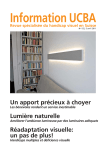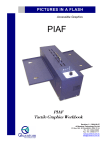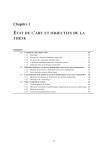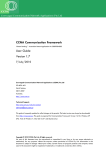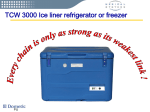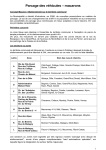Download User Guide - Swissquote
Transcript
Swissquote Bank Trading Console User Guide © 2005-2013 SWISSQUOTE BANK LTD all rights reserved. The content of this document is confidential and the intellectual property of SWISSQUOTE BANK LTD. This documentation is protected by copyright and distributed under licenses restricting its use, copying and distribution. No part of this documentation may be reproduced in any form by any means without prior written authorization of SWISSQUOTE BANK LTD. CONTENTS QUICK OVERVIEW ............................................................................................................................................... 3 Main Screen – quick description .................................................................................................................... 3 Market News................................................................................................................................................... 4 Reporting ........................................................................................................................................................ 5 TRADE EXECUTION .............................................................................................................................................. 7 Market Order .................................................................................................................................................. 7 Entry Orders .................................................................................................................................................... 8 1. Limit Orders ...................................................................................................................................... 9 2. Stop Orders..................................................................................................................................... 10 3. Trailing Stop orders ........................................................................................................................ 11 Related Orders .............................................................................................................................................. 12 1. OCO (order cancels other) .............................................................................................................. 12 2. IF DONE........................................................................................................................................... 13 3. IF DONE / OCO ................................................................................................................................ 14 Modifying or Canceling orders ..................................................................................................................... 15 1. Cancel Order ................................................................................................................................... 15 2. Modify Order .................................................................................................................................. 16 OPEN POSITIONS............................................................................................................................................... 18 Open Positions (detail) ................................................................................................................................. 18 Open Position (summary) ............................................................................................................................. 19 Linked orders ................................................................................................................................................ 19 Account Overview ......................................................................................................................................... 20 Margin Requirements ................................................................................................................................... 21 P&L CALCULATIONS .......................................................................................................................................... 22 TRADING MARGINS........................................................................................................................................... 23 OVERNIGHT POSITIONS .................................................................................................................................... 24 CHARTS ............................................................................................................................................................. 24 © Swissquote Bank Ltd Console trading - User guide | 2 QUICK OVERVIEW Main Screen – quick description 1 2 6 5 3 4 8 7 1. Trading Boxes One box for each currency pair. View real time bid/ask rates. Click on the BUY or SELL to execute a trade. 2. Live Trading Quotes View a list of real time bid/ask quotes as well as today's highs/lows, etc. 3. Chart Tool Real time charts on all currency pairs. Many customizable technical analysis tools are accessible. 4. Open Positions (detail) Real time summary view of all open positions. Place orders linked to the selected position or close selected position. 5. Open Positions (summary) Real time summary view of all open positions consolidated by currency pair. Close selected position. 6. Account Overview View real time information about margin, P&L and account balances. © Swissquote Bank Ltd Console trading - User guide | 3 7. Order book & Trade Log View real time information about all open trades, as well as trades that have been closed out during the selected period. Create new, cancel or modify orders. 8. Market News View containing the latest news published. Market News This view is composed of a folder containing the latest news published. The second folder contains archives which provide specific search criteria to retrieve particular kinds of published news. © Swissquote Bank Ltd Console trading - User guide | 4 Reporting Five kinds of statements are available in the SWISSQUOTE BANK trading console: "Account Statement", "Account Summary", "Transactions Summary", "Closed Trades", and "Today's Activity". The "Account Statement" returns the balance of the trading account, the list of all open positions and the list of pending orders. The "Account Summary" displays all the cash movements on the account and details the origin of such movements: type of transaction (Forex trade, deposit/withdrawal, overnight swap, etc.). In the example of a P&L paid, the report contains the information of the entry and close price, the (historical) exchange rate between the currency of the P&L and the reference currency of the account. The "Transaction Summary" returns the list of all transactions grouped by transaction-type performed on that trading account. These order types include Forex trades, Overnight Swap (Rollovers-) operations, etc… The "Closed Trades" returns the list of all booked orders grouped by Order-Id (=Ticket) with the amount, bid & ask values and P&L for each currency pair traded. The reports "Account Summary", "Transaction Summary" and "Closed Trades" can be generated by selecting a period of activity. By default the current month is selected. © Swissquote Bank Ltd Console trading - User guide | 5 The report "Today's Activity" is a derivation of both "Transaction Summary" and "Account Summary" but focused on today. Please carefully review all transactions on this statement and report any differences immediately. The failure to report differences within 30 minutes after a difference has occurred will be considered as an agreement that this statement is correct and ratified. Swissquote Bank Ltd reserves the right to annul transactions made online by a customer within the space of 48 hours after the transactions were made. © Swissquote Bank Ltd Console trading - User guide | 6 TRADE EXECUTION Market Order A market order (Spot) is an order to buy or sell at the current market price. Customers using Swissquote Bank’s online trading platform click on the buy or sell button after having specified their deal size. The execution of the order is instantaneous. The most common way to place a market order (Spot) is to use the trading box. The real time bid/ask prices appear in the trading box for each currency-pair. A client only needs to click on the current bid or ask offer for execution of the trade. Click to SELL at current bid Click to BUY at current ask Permit to place SPOT orders as Market Best The first step to passing an order is to select an amount from the proposed drop-down list. The combo box is editable, so that the client can edit the desired amount, which must be a multiple of the lot. The second step is to click one of the prices to sell or buy at the proposed price. At market best option : This order is filled at the first available price; the order is filled for the full amount but can be filled differently than the asking price. A green box confirms the deal was executed. A red box will contain the reason for which the trade has not been executed. © Swissquote Bank Ltd Console trading - User guide | 7 Entry Orders Two possibilities are offered to the client for placing an entry order. The client may either choose the desired type of order in the menu "Place order" or by right-clicking in the view "Order List" The description of each order type is then presented in the next section. © Swissquote Bank Ltd Console trading - User guide | 8 1. Limit Orders A limit order is an order placed to buy or sell at a certain price. The order essentially contains four variables: price, duration, direction and size. The trader specifies the price at which they wish to buy/sell a certain currency pair, specifies the Expiration Type, the amount of time that the order should remain active and the size of the order. GTC (Good till cancelled): A GTC order remains active in the market until the trader decides to cancel it. The dealer will not cancel the order at any time therefore it is the client's responsibility to remember that the order is in place. GFD (Good for the day): A GFD order remains active in the market until the end of the trading day. Since foreign exchange is an ongoing market, the end of day must be a set hour. For Swissquote Bank the end of the trading day occurs at exactly 23:00 CET. Entry Limit Note here that our trading system will only validate limit buy orders with a limit price below the actual market price. For sell order, the limit should be higher than the market price. If these rules are not respected, the Swissquote Bank trading system will reject that order and return an error message to the trader, with an indication of which direction it makes sense to trade in. © Swissquote Bank Ltd Console trading - User guide | 9 2. Stop Orders A stop order is an order to buy or sell when a specific price is reached, either above (on a buy) or below (on a sell) the price that prevailed when the order was given. A stop order to buy, always at a higher price than the current market price, is usually designed to protect a profit or limit a loss on a short sale. A stop order to sell, always at a lower price than the current market price, is usually designed to protect a profit or limit a loss on a position already purchased at a higher price. From the trader’s point of view, a buy stop order is placed when the trader believes that if the price moves upwards and reaches a certain limit, the price will continue its trend and continue upwards. In the case of a sell stop order, the trader believes that if the price moves downwards and reaches a certain limit, the price will continue its trend and continue to move downwards. The main difference with a limit order is that the trader believes the opposite behavior once the limit price has been reached. The order contains the same two variables, Amount and Expiration Type. The same variations are used to specify the expiration as in limit orders (GTC and GFD). Let's look at the following examples: Example: Trader x buys EURUSD 100'000 @ 1.3302, expecting a 60 to 70 pips move in the market, but wants to safeguard against an overestimation of the potential strength of the Euro. Trader X knows that 1.3272 is a strong support level and therefore places a stop loss order to sell at that level. Trader X has limited the risk on this particular trade to 30 pips or USD 300. Another usage of a stop order is when a trader is expecting a price breakout to occur and wishes to grasp the opportunity to 'ride' the breakout. In this case a trader will place an order to buy or sell 'on stop'. To illustrate the logic behind this, let's review the following scenario: Example: Trader x sees EURUSD breaking through the 1.3310 resistance level. He believes that if this happens, the price of EURUSD could be headed to 1.3340 and over. At this point the market is at 1.3302 so Trader X places an order to initiate a buying position of 100'000 at 1.3310 'on stop'. © Swissquote Bank Ltd Console trading - User guide | 10 Note here that the Swissquote Bank trading system will only validate stop buy order with a triggering price above the actual market price. For sell order, the stop limit price should be below the market price. When these rules are not respected, the Swissquote Bank trading system will reject that order and return an error-message to the client, with an indication of which direction it makes sense to trade in. 3. Trailing Stop orders Placing trailing stop orders is similar to a normal stop order with the difference that additional order parameters are prompted to specify Trailing Points, which is the number of pips from the current rate at which you want the stop loss order to be executed at. The advantage of a trailing stop is that the order automatically “trails” the rate if the position moves in the trader’s favor, offering the potential for greater gains while still guarding against price declines. In the example below, the live rate is 1.3342 and the Trailing Stop is set to 10 pips. Assume that the position would be opened at 1.3332 by the IF order section. The buy stop order will be filled if EURUSD ask reaches 1.3334 (1.3332 – 2 spread – 10 pips). If EURUSD moves in the trader’s favor, e.g. down 5 pips, the stop order will automatically adjust to 1.3329 - always 10 pips from the live rate after the IF section execution. Technically speaking, the only difference with a normal stop order is that the stop price changes as the order “trails” the market price action in the trader’s favor. Entry Stop © Swissquote Bank Ltd Trailing Stop Console trading - User guide | 11 Related Orders At this point, we will present how the use of related trade orders to link orders will together help to create more complex trading strategies. OCO (order cancels others) and IF DONE orders (also known as slave orders) are typically used in that context. 1. OCO (order cancels other) An OCO order is a mixture of one limit and one stop order. Two orders with price and duration variables are placed above and below the current price. When one of the orders is executed, the other order is cancelled. To illustrate how an OCO order works let's take the following example: The price of EURUSD is 1.3318. Trader x wants to either sell 100'000 at 1.3307 below the resistance level in anticipation of a breakout or initiate a selling position if the price reach 1.3327. © Swissquote Bank Ltd Console trading - User guide | 12 2. IF DONE Two-legged order whereby the second single order (stop loss or take profit) is placed only upon execution of the first single order. © Swissquote Bank Ltd Console trading - User guide | 13 3. IF DONE / OCO This is a variation of the IF DONE order whereby an OCO (stop loss and take profit, where the execution of one order cancels the other order) is placed after the order in the IF section has been successfully executed. © Swissquote Bank Ltd Console trading - User guide | 14 Modifying or Canceling orders Each pending order can be canceled or edited in order to modify parameters. From the "Order book & Trade Log" view, right click on the order and select the appropriate action. 1. Cancel Order By right-clicking on "Cancel Order", the trader will be prompted to confirm the cancellation of the trade. The pending order is then removed from the order queue and will no longer be executed. The following confirmation message is displayed to the trader: © Swissquote Bank Ltd Console trading - User guide | 15 2. Modify Order By right-clicking on "Modify Order", the appropriate order editor is displayed and all parameters can be modified. Click the "Place" button to validate the modifications and replace the old order with the new one in the system. Attention is required, as long as the order has not been (re)placed, the old one is still valid. Modifying a simple Stop order © Swissquote Bank Ltd Modifying an IF – DONE Trailing order Console trading - User guide | 16 Modifying an IF – DONE order © Swissquote Bank Ltd Modifying an IF – DONE OCO order Console trading - User guide | 17 OPEN POSITIONS A position is deemed ‘open’ if it has not been offset by an equal and opposite deal (if hedging is deactivated). An open position is defined primarily by the quantity of the underlying instrument (or asset) and the price at which it was opened. An open position can be long if the trader bought the underlying asset or short if the trader sold that position. Note that, an asset can be sold before being bought. A long or short position can be closed or reduced but not increased. If a client wants to increase the exposure on an instrument, a new position will be created. On Swissquote Bank trading platforms, each open position is displayed with corresponding unrealized Profit & Loss (or open P&L). Normally, all positions on a specific instrument are opened in the same direction (long or short). For example a client can only have long positions in EURUSD, but not simultaneously long and short positions. If the client decides to place a trade in the opposite direction of the current exposure, some open positions will be closed or reduced (given the hedging function isn’t activated). If no instruction has been given, the oldest open positions will be closed first, following the FIFO (First In First Out) rule. FIFO rule is not followed when an order is linked to a given open position. When a linked order is executed, its linked position will be closed or reduced. Open Positions (detail) One of the specificities of the SWISSQUOTE BANK Java Trading Platform is the possibility to manage many open positions in the same currency pair. A new (open) position is created when the execution of an order increases the exposure on the traded currency pair. In the example above, many buy orders have been executed on the EURUSD. Each of these orders has generated a new position. The calculation of the P&L is specific to each position and is relative to the entry-price of that position. When the execution of an order reduces the exposure on the traded currency-pair, the FIFO (First In First Out) rule will apply, and the oldest position on the traded currency pair is closed or reduced. If the amount of the order is larger than the amount of the closed position, the next oldest position is reduced or closed. This process will continue as long as the entire amount of the order has not been booked. If all positions are closed and there is still an available amount which has not been booked, the order reverses the exposure from long to short (or from short to long). A new position with the residual amount will be created in the opposite direction. The section Linked order describes how to close a specific position among all positions listed in this view. © Swissquote Bank Ltd Console trading - User guide | 18 Open Position (summary) A consolidated view of all positions can be displayed by selecting the menu-item ‘Open Positions (summary)’ in the ‘Forex View’ menu. This view shows exactly one entry for each currency pair. The average open price and the P&L (profit and loss) is calculated for each consolidated position. Linked orders Orders linked to an open position are called Linked orders. It means that the execution of linked orders will only affect the linked position by closing it. Linked orders are easily configured by the client. The client simply needs to select a position from the list of all open positions by right-clicking on it and selecting the appropriate order type to close that position. © Swissquote Bank Ltd Console trading - User guide | 19 Account Overview The margin analysis window provides traders with real time information about their trading account. Account Balance The quantity of money resulting from the sum of all deposits and realized gains minus all withdrawals, realized losses, costs and fees which have been booked on the money account Open Profit/Loss The net P&L of all open positions, calculated at the current rate. This amount changes as the rates fluctuate. Available Equity Represents Account Balance plus the total of current unrealized gains/losses. Max Trade Size The maximum position expressed in the reference currency of the client which the margin balance will allow to trade. At 1% margin, this represents 100x the current margin balance, if no position is open. Margin Level represents the ratio between the Available Equity and the absolute sum of all open positions. This ratio is expressed in percentage. © Swissquote Bank Ltd Console trading - User guide | 20 Margin Requirements Day/Overnight margin represent the margin level at which all open positions will be liquidated (closed) during the day or overnight. The margin can and will change depending on the total (absolute) dollarized value of all current positions held. Day margin requirement is applicable from 08:00 CET to 22:49 CET. Overnight margin requirement is applicable from 22:50 CET to 07:59 CET. Please follow this link for exposure thresholds and their respective margin requirements. http://www.swissquote.com/fx/products/trading_conditions/Spreads.action Please Note Clients will be expected to be fully aware of their margin requirements and trade accordingly. SWISSQUOTE BANK Declines all responsibility as to the untimely liquidation of positions due to an automated margin change. Margin Requirement rules: If a client has a margin requirement above 1.00% during the day, he/she will be notified upon closure of the platform or at 22:30 CET that his/her margin requirement will change for the night at 22:50. If and when the client attempts to open a position that will; a.) Take the client passed a superior margin requirement threshold. And, b.) Passed his/her margin level (liquidation) the platform will refuse the order. Margin Thresholds reached/passed through market moves (due to dollar exchange rates) as well as additional positions opened by the client will trigger a warning for the client. Client accounts denominated in currencies other than USD will have thresholds calculated in real time to the equivalent dollar amount. © Swissquote Bank Ltd Console trading - User guide | 21 P&L CALCULATIONS Gain or loss resulting from the closing of a position. The P&L calculation uses the formula: (Closing price - purchase price) x (position amount). For example, a client buys 100’000 EURUSD at 1.3400 and later he closes at 1.3410. The generated P&L is: (1.3410 - 1.3400) x 100’000 = 100 USD Note that if the account is expressed in EUR, the amount will be credited after an exchange rate has been calculated with the mid-price between the bid and ask price at closing. In the above example, if we consider that the client trades on 2 pips, the bid-price is 1.3410 and the ask-price is 1.3412. The 100 USD are converted into EUR by using the following mid-rate: (1.3412 - 1.3410)/2 = 1.3411; the realized P&L is: 100 USD/1.3411= 74.5656 EUR. Each open position has a corresponding unrealized P&L (or open P&L) which is calculated using the formula: (Current price - purchase price) x (position amount) expressed in the counter currency of the traded currency-pair. © Swissquote Bank Ltd Console trading - User guide | 22 TRADING MARGINS A margin deposit is not, as many traditional traders suggest, the payment in cash for purchasing market shares. A margin is in fact a guarantee or a trust deposit, providing protection from losses during a deal. It allows traders to open positions on amounts that greatly exceed their account limits and so increase their buying power. For a full explanation of Swissquote Bank’s FX margin rates please visit our website www.swissquote.com/fx The formula for calculating margins is as follows: Margin = equity/exposure Equity = balance + open P&L Exposure = sum (open positions) The equity and the open P&L must be expressed in the same currency (for example USD). Here is an example: Let’s consider a client with 10’000 USD in his account with an open position of +500’000 EURUSD opened at 1.3594 quoted actually at 1.3600. The actual open P&L is 300 USD. The equity is: 10’000 + 300 USD = 10’300 USD. The exposure is equal to: exposure = 1x500'000 EURUSD-->500'000 EUR x 1.36 = 680'000 USD Margin = equity / exposure=10300/680000 = 0.015147 1.51% © Swissquote Bank Ltd Console trading - User guide | 23 OVERNIGHT POSITIONS Traditionally inter-bank foreign exchange transactions are settled on pre-arranged value dates. In other words, if a trader sells 1 million EUR against USD spot on Wednesday, that means he must deliver the value of 1 million Euros on Friday in order to receive the USD equivalent sum based on the exchange rate agreed upon. (Settlement dates in the spot market are valued on a 2 working day basis). SWISSQUOTE BANK adopts a method of operation by which there are no value dates on any operations and no close out and reopening of open positions at close of business. We call this process a synthetic spot transaction. This results in a simple one line transaction on the customer's transaction statement instead of an extremely complicated multi-entry statement which is generally unintelligible for anyone not very well acquainted with interbank transactional dynamics. SWISSQUOTE BANK applies a cost of carry on behalf of the market or the customer on open positions held overnight. This overnight cost of carry is presented as a simple flat fee either paid or charged on a customer's account. This process makes for extremely simple statements and greatly increases execution transparency since we do not modify the original price of the position entered into by the customer. Please note that the "total open position" for precious metals is the equivalent dollarized value. Example 200 ounces of gold are worth about 177'000 USD (08/04/2009 rates). Overnight costs are credited & debited on any positions held after 23:00 CET every day of the week. Please note that SWISSQUOTE BANK applies a triple swap Wednesday evenings to account for weekend rollovers. The fees applied for credit and debit can be found at the following URL, which is updated daily according to market conditions: http://www.swissquote.com/fx/products/trading_conditions/SwapRates.action CHARTS A complete charts user guide presentation is available at the following link: http://www.swissquote.com/fx/trading_software/trading_software_troubleshooting.jsp © Swissquote Bank Ltd Console trading - User guide | 24 Headquarters Swissquote Bank Ltd Chemin de la Crétaux 33 CH - 1196 Gland T +41 22 999 94 11 F +41 22 999 94 12 Zurich Office Swissquote Bank AG Schützengasse 22/24 CH - 8001 Zurich TEL. 0848 25 88 88 FAX. +41 44 825 88 89 Bern Office Swissquote Bank AG Schauplatzgasse 9 3011 Berne TEL. 0848 25 88 88 FAX. +41 44 825 88 89 Dubai Office Swissquote Bank Ltd (DMCC Branch) Jumeirah Lakes Towers, Almas Tower Level 33, Office 33J P.O.Box 121364, Sheikh Zayed Road Dubai, UAE TEL. +971 4 450 1700 FAX. +971 4 450 170 Swissquote Europe Ltd Tower Business Centre Tower Road, Swatar BKR 4013 Malta TEL. +356 2546 6720 FAX. +356 2546 6103 Customer Care Center TEL. 0848 25 87 88 From abroad : TEL. +41 44 825 87 88 www.swissquote.ch / www.swissquote.com/fx

























